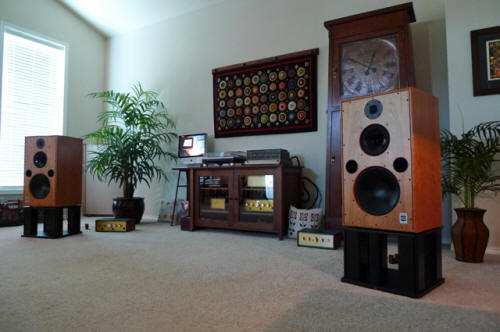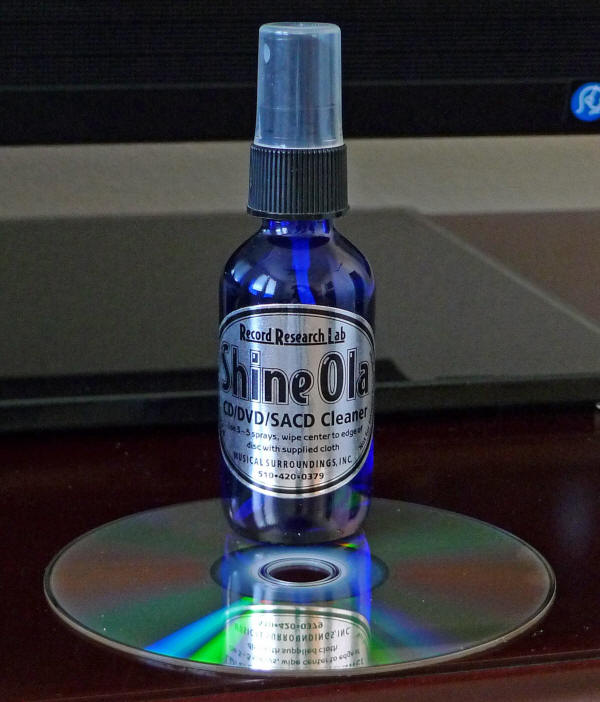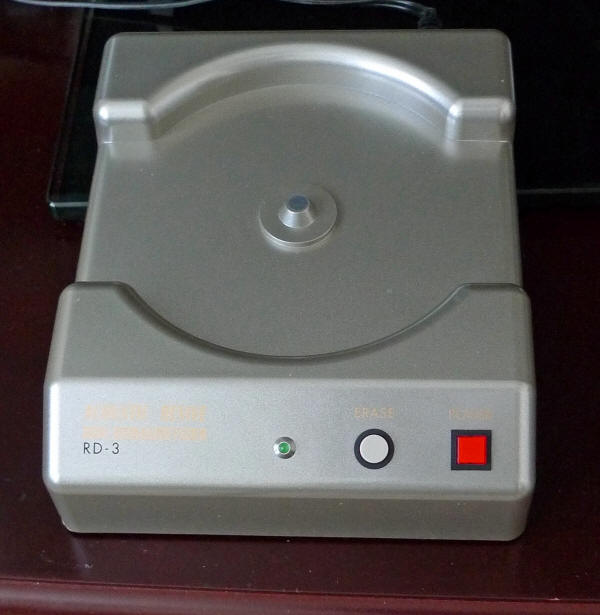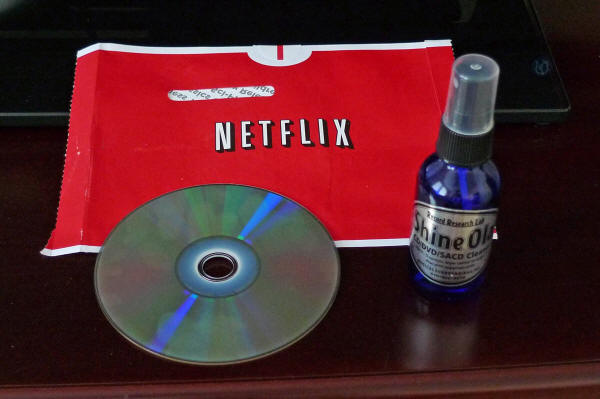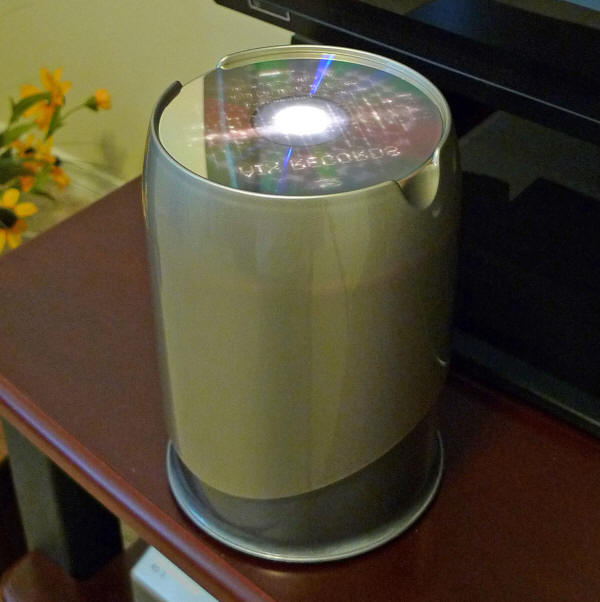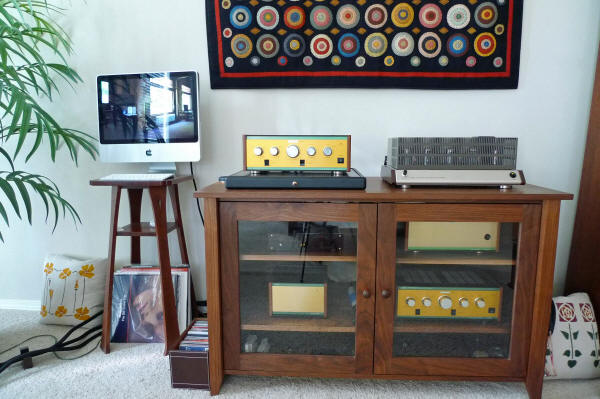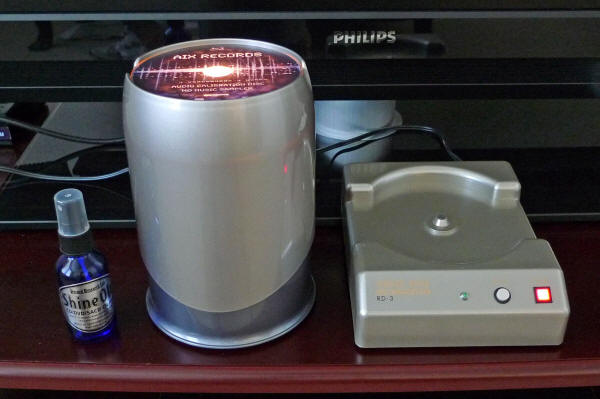|
You are reading the older HTML site Positive Feedback ISSUE 45september/october 2009
Getting Top Performance From Your Digital Media:
Shine Ola Optical Disc Cleaner, the Acoustic Revive RIO-5II Negative Ion
Generator, and the Acoustic Revive RD-3 Disc Demagnetizer
It's common knowledge that cleaning vinyl records makes a big difference in the quality of playback. If you've never cleaned your records, the first time you do it can be quite a shock. I remember the first time I cleaned my records, many years ago now, and I found out that most of the snap, crackles, and pops that I thought were part of the vinyl experience disappeared after cleaning. I also found that when I started with pristine new vinyl and kept it nice and clean it sounded as quiet as can be—as quiet as a CD in fact. Clean records make for better sound and for more fun while listening to music, thus the popularity of record cleaning machines in the homes of vinyl aficionados. When you think about LPs it's pretty obvious that any dirt or grime in the grooves will negatively affect sound, as it presents an obstacle course for the stylus to run through as it traces the groove. For a visual think about running barefoot across a clean floor versus one with bits of broken glass scattered across it. Your feet will be happier with a clean floor just like the stylus will be happier with a clean record. With LPs there is a mechanical connection between stylus and groove that thanks you for your cleanliness by rewarding you with better sound and more fun listening to music, but does it make a difference to clean optical media like CDs, DVDs, SACDs, Blu-ray discs, and the like, where there isn't a mechanical connection? I've found that it does make a significant difference to clean and treat optical media, and for those music and film lovers looking to get top performance from your digital media, I think you'll find it to be indispensible. I've been using three different products in my cleaning and treating regimen for a while now: First I use the Shine Ola spray on cleaner to get any crud off the disc, followed by treatment with an Acoustic Revive RIO-5II negative ion generator, and concluding with treatment by an Acoustic Revive RD-3 disc demagnetizer. I've found that by using these three products in combination as a cleaning and treating system can produce quite a dramatic improvement in both sound and video quality from optical media discs.
Shine Ola Optical Disc Cleaner ($25 USD) I've been using a $25 spray on cleaner called Shine Ola to clean my optical discs. The label on mine says "Record Research Labs," but I couldn't find it being offered by RRL anymore. However, it appears that the exact same product is being sold by Mobile Fidelity now, and while the label is different, the bottle is still the same and it's still called Shine Ola. The idea behind Shine Ola is that it cleans off the crud left on the discs after the pressing process, which allows the laser to track the data better, and provides better sound as a result. For your $25 you get a little 2-ounce spray bottle of Shine Ola cleaner and a small 3M micro fiber cloth to use for scratch-free wiping duties. 2-ounces of Shine Ola is supposed to allow you to clean 200-350 discs, but in practice I've found it cleans more discs than that, so it's a relatively inexpensive thing to do.
Acoustic Revive RIO-5II Tourmaline Negative Ion Generator ($995 USD) As you can see in the accompanying photos, the RIO-5II (which I like to call somewhat incorrectly "the photon cannon") is a cylindrical device that you place your discs on top of for treatment. Just below where the disk sits is a screened off compartment containing piezoelectric tourmaline minerals. According to Acoustic Revive, when you power up the RIO-5II internal halogen lamps light up and excite the tourmaline, causing it to release negative ions. An internal fan blows air containing the negative ions up and over the disc, treating it. After treating one side of the disc you then flip it over and treat the other side the same way.
Acoustic Revive RD-3 Disc Demagnetizer ($495 USD) I'll try to summarize briefly how the RD-3 works, but you should really check out the Acoustic Revive website, where there is an abundance of information on the technical aspects of the RD-3. In summary: There are ferromagnetic substances used in the inks on the label side of optical discs, and ferromagnetic impurities within the aluminum substrate of the disc. When discs are played they are exposed to a magnetic flux from the electronics, which magnetizes the ferromagnetic materials in the inks and the impurities in the aluminum substrate. This in turn degrades the ability to get data cleanly off the disk, compromising sound and video quality. So the idea is that by demagnetizing the discs with the RD-3, the discs are restored to a non-magnetic state so data can be recovered from the disc without compromise, giving you the maximum in sound and video quality. Just as with the RIO-5II, with the RD-3 you treat one side of the disc, then flip it over and treat the other side. Cleaning and Treatment Observations
I've been using Shine Ola for quite a while now and have found it to be an effective way to clean discs of any type. For example, with really dirty discs that come in the mail from my Netflix subscription, Shine Ola can be a lifesaver. Discs from Netflix are often scratched up, and all smudged up with grimy fingerprints and lord knows what else, so much so that at times they won't even play without a good cleaning with Shine Ola first. I suppose that it's intuitively obvious that cleaning the gunk off of really crapped up discs will make a big difference (no surprise), but it also helps improve the sound of new and pristine discs as well. While the magnitude of difference that Shine Ola makes seems to vary somewhat from disc to disc, probably depending on how much it really needed cleaning, what I've observed overall is that the audio improves by becoming more natural and analog sounding. The resulting sound is less edgy, less bright, less pejoratively ‘digital', and has a smoother, more spacious, more transparent, and slightly warmer overall sound. The effect of a Shine Ola cleaning on the sound is not huge, but it is often enough to turn a borderline sounding disc into a decent sounding disk.
The Acoustic Revive RIO-5II Tourmaline Negative Ion Generator is an intriguing product, and frankly, even after reading the discussion of how it works on the Acoustic Revive website I'm not really sure why it improves sound and video quality to the extent it does, but it surely does, and in rather dramatic fashion. It must be some sort of surface effect where the negative ions interact with surface of the disc, but beyond that I couldn't tell you what's going on. After treating both sides of a disc with the RIO-5II the audio is rather dramatically transformed. When going from an untreated disc to a treated disc there was a noticeable increase in dynamics, and it almost seemed like there was a sizeable increase in volume, even though there wasn't. There was also a significant increase in transparency, with more detail being apparent, and a noticeable increase in the solidity of imaging. The sense of space around images, the overall sense of space in the recording, and the soundstage depth also increased quite noticeably. There was a slight downside with using the RIO-5II by itself though, as some of the brightness and edginess that is erased after cleaning discs with Shine Ola creeps back in with all that additional resolution and transparency.
Enter the Acoustic Revive RD-3 Disc Demagnetizer: I suppose the reason I consider these three techniques to be a cleaning system is because of the huge synergy that results from using them together. First you clean off the disc with Shine Ola to prepare it, and then treat it with the RIO-5II for a huge increase in audio (and video, more about that in a moment) performance, and finally you treat it with the RD-3. The RD-3 restores the natural balance back without any loss of the benefits already gained by using the RIO-5II. In fact you end up with an even more spacious, more transparent, more detailed presentation than by using the RIO-5II by itself, except it is now smooth and natural sounding without a hint of brightness or edginess. Using the RD-3 by itself also yields a significant improvement, but just not to the extent that using it in combination with the RIO-5II does.
The improvement is not limited to just playing the discs back in a disc player either, as I have found that the improvement gained through cleaning and treating is maintained when ripping CDs to my iMac for music listening through the Mhdt Labs Havana USB DAC. While the increase in audio performance is quite predictable, the effect of this cleaning regimen on video seems to vary with the quality of the video on the disc. With lower quality video on DVD I didn't really notice any significant difference in quality, probably because the poor overall video quality swamped out any real improvements wrought by the cleaning and treatment. As DVD video quality improved I noticed more ability to see the difference wrought by cleaning and treating, with the images becoming more detailed and defined, and the colors more natural looking. Where I noticed a particularly impressive video quality improvement was with the high resolution Blu-ray format. In fact I almost fell out of my chair after cleaning and treating my first Blu-ray disk, as the effect was so profound. The level of detail resolution increased dramatically, almost shockingly, the colors became more even, and along with the already mentioned audio enhancements the overall improvement was astonishing. It's a little hard to assign a magnitude of improvement for each of the cleaning and treatment methods, but let me try. On a scale of 1 to 10, if cleaning with Shine Ola wrought an improvement of 2, the RD-3 wrought an improvement of 6, and the RIO-5II a 10. But that's not the end of the story, as using this as a system brings about a bigger gain than just the sum of the parts does. So instead of ending up with a total improvement of 2 + 6 + 10 from the individual treatments, you get something more like double that. I also noticed that the higher resolution and quality of the media, the more pronounced the effect of cleaning and treatment is. I also suspect that the more resolving your electronics are, the more you will notice the benefits as well. As a final important note, the order you do things in matters. The best performance comes from first cleaning the disc with Shine Ola, then treating both sides of the disc with the RIO-5II negative ion generator, and finally treating both sides of the disc with the RD-3 demagnetizer. Also, I like to clean and treat a disk prior to each use, even if it has been cleaned and treated previously, to ensure the best performance. Summary and Conclusions
For the music and film enthusiast looking for the highest performance from their digital media, a disc cleaning and treating regimen is as important as it is for vinyl record playback for achieving maximum performance, and for high performance video using Blu-ray it may even be more important in achieving the ultimate quality the format is capable of. Although using these three techniques together as a system of cleaning and treatment isn't inexpensive, it's comparable to the cost of a quality record cleaning system, and in that sense I think the price isn't out of line. If you want to get the most out of your digital media in a high-performance audio or video system, I can't think of a better way to do it. Highly recommended. Shine Ola from Mobile Fidelity Sound Labs: http://www.mofi.com/productcart/pc/viewPrd.asp?idcategory=11&idproduct=109 Acoustic Revive products are imported to the USA by the Lotus Group:
|

